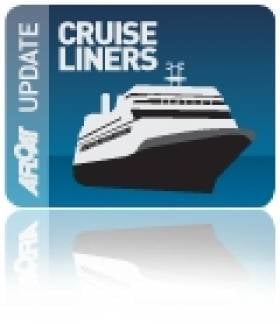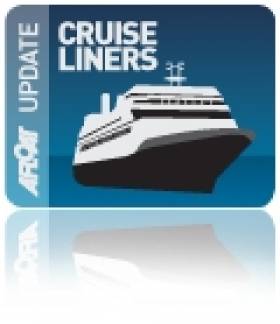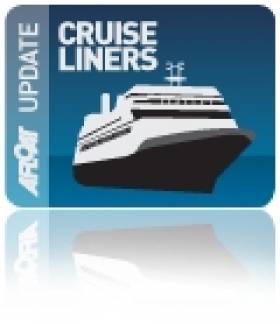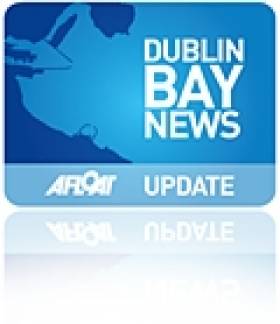Displaying items by tag: Cruise Liners
#CorkCruiseDouble – Cork Harbour today welcomed two very large cruiseships, though at separate locations due to the combined length of these impressive vessels, writes Jehan Ashmore.
The larger of the two Princess Cruises callers, the 330m long Royal Princess named by Catherine, Duchess of Cambridge, in 2013, entered Cork Harbour after the Caribbean Princess. The later cruiseship albeit smaller at 290m is still a large vessel in terms of those calling to an Irish port.
Royal Princess of all 141,000 gross tonnes has a 3,600 passenger /1,300 crew total and had berthed alongside Cobh from where her newer sister Regal Princess also called late last month.
More cruiseships from the Carnival Corporation brand have visited Cobh down through the years among them Cunard Line's Queen Elizabeth.
Elder sister Queen Victoria as previously reported is on a 'Remembering Lusitania' commemorative cruise to Cobh this Thursday, the day the liner sank a century ago during WWI when U-Boat 20 fired a torpedo that led to a huge loss of life.
Royal Princess had sailed from Ponta Delgada, Azores and likewise the 112,894 tonnes Caribbean Princess with up to 3,100 passengers.
Another double-take is that both vessels were built by Fincantieri in Monfalcone, Italy and equally they draw the same draft of 8.5m.
As previously reported on Afloat.ie, the cruise-quay facility at Cobh recently underwent phase one of €1.5m upgrade to facilitate even larger cruiseships, notably RCI's mega 'Quantum' class of 347m in length. These massive 168,000 tonnes cruiseships with almost 5,000 passengers are expected to visit the Port of Cork's Cobh Cruise Terminal but not until at least 2017.
The facility can currently accommodate two cruiseships at the same time though in comparison notably smaller sized ships to what the future holds.
So where in the case of today's double call scenario did the 3,100 passenger Caribbean Princess go to berth? The large 'Grand' class cruiseship had sailed beyond Cobh to another deepwater quay alongside Ringaskiddy.
This is where Cunard Line's 'liner' 'QE2' had berthed as well as to Cobh where she bade her final farewell visit in 2008. Her successor Queen Mary 2 has made calls to the lower Cork Harbour town cruise destination.
As for the Princess pair they are scheduled to depart this evening half an hour apart from 20.00hrs. In total the port is expected to see 55 cruise calls this season.
#Cunard175th - Cunard Line's three 'Queens' departed Southampton this evening to mark the start of celebrating the world famous company's 175th anniversary, writes Jehan Ashmore.
Leading the way from the UK homeport was Queen Mary 2, the 151,000 tonnes 2,600 passenger flagship cruise 'liner' which along with her fleetmates departed down Solent water and out into the English Channel.
The procession saw the cruiseship trio pass Cowes, Isle of Wight and at 19.00hrs this evening when Queen Victoria set off on a RMS 'Lusitania Remembered' memorial commemorative cruise to Cobh. She was astern of Queen Elizabeth which likewise of 'QM2' are all to visit Irish ports this season.
The 'Vista' class Queen Victoria is to call to Cobh Cruise Terminal next Thursday in memory of the sinking of the RMS Lusitania 100 years ago. The liner was sunk by a torpedo from German submarine (U-Boat 20) on 7 May 1915.
It was in the previous century that Cunard began operations with Britannia when she left British waters in 1840 bound for America. Ever since the prestigious luxury brand have taken guests between the continents.
Below is outlined the current Cunard fleet and each of the captains in command of the cruises that began this evening and to where each of the respective cruiseships next port of call.
Queen Mary 2 (Captain Christopher Wells) set sail bound for New York
Queen Elizabeth (Captain Inger Klein Thorhauge) is heading for Hamburg
Queen Victoria (Commodore Christopher Rynd) underway for St. Peter Port, Guernsey
All three cruiseships have previously called to Irish ports, notably Queen Mary 2 which made her debut off Dunmore East, Waterford Estuary in 2005.
Biggest Ever Cruiseship to Dublin Port In Advance of Dun Laoghaire's Largest Passenger Call
#DublinsBiggestShip – Dublin Port is to have the biggest ever ship of any type to call when cruiseship MSC Splendida of all 137,926 gross tonnes is to make her Irish debut instead of anchoring firstly offshore of Dun Laoghaire Harbour, writes Jehan Ashmore.
According to Dublin Port Company CEO Eamon O'Reilly, who was speaking at the recent Dublin Bay Conference which was held in the Gibson Hotel overlooking the site of the proposed €30m cruise terminal, the MSC Splendida is to call on 11 May, the same day original scheduled for her anchorage call off Dun Laoghaire.
It is not known why the huge 18-deck 'Fantasia' class 333m long cruiseship has swapped ports, though there are many variables in the shipping industry over the re-scheduling of vessels.
Having said that MSC Splendida is to call offshore of Dun Laoghaire Harbour on the 21st May of the following week. When she does the 3,900 passenger accommodation vessel makes her the largest in capacity terms of this seasons record breaking 22 cruiseships calling within the harbour and anchoring offshore.
Added to the MSC Splendida's tourists will be a crew of around 1,370 which is close to that of the 1,500 passenger former Dun Laoghaire-Holyhead fast-ferry HSS Stena Explorer.
This leaves another massive cruiseship, Royal Princess of 142,714 tonnes (see, Belfast's biggest caller 2014) to become the first caller this season for the Dun Laoghaire Harbour Company when she takes anchorage in south Dublin Bay on 12th May. The 330m cruiseship has a 3,560 passenger capacity.
Another yet repeat caller is Cunard's Line's flagship cruise 'liner' Queen Mary 2 (QM2) which at 151,000 tonnes and 2,600 passengers is due to call offshore on 20th May, the day before MSC Spendida's inaugural call.
The QM2 is 61.9m high while the MSC Splendida is even higher towering at almost 70m. Such-sized ships and larger could enter Dun Laoghaire Harbour as proposed by the €18m single cruise-berth in which the DLHC are understood to lodge this month a planning application accompanied by an Environmental Impact Statement (EIS) to An Bord Pleanala.
MSC Splendida is operated by MSC Cruises, the passenger arm of the Mediterranean Shipping Company that run container services to Dublin Port. When she calls, the massive cruiseship is to enter the port entrance astern, this is due to current restrictions of the port layout and the relationship to her sheer size and water depth notably when berthing in the confines of Alexandra Basin. This area of the port forms part of the port's 'Masterplan 2040' as the Alexandra Basin Redevelopment (ABR) reconfiguration project is to cost €200m.
The arrival of MSC Splendida will be a clear demonstration as to why the Dublin Port Company propose the €30m cruise terminal facility. The double cruise-berth facility is to accommodate such ships and those of the next generation mega cruiseships. A decision from An Bord Pleanala over the proposed cruise terminal and associated EIS is already currently underway.
Aside all the focus on cruiseships due to the controversary of potentially having two new cruise terminals in Dublin Bay totalling almost €50m, one could easily forget the real driver of the economy is that of cargoships exporting our trade.
As such increasing larger deeper drafted cargoships also need to enter Alexandra Basin and elsewhere in the port. This is where the rest of the masterplan is to meet the rising demands of the shipping industry coupled with economies of scale and capacity demands as record trade figures are broken and are forecast.
#SOSDunLaoghaire - The Save Our Seafront (SOS) group says large cruise-berth 'inappropriate for our Victorian harbour' writes yesterday's Irish Times.
Approximately 150 attended a public meeting in Dún Laoghaire organised to mount a "major campaign" against a proposed cruise berth in the harbour.
Dún Laoghaire Harbour Company is to seek planning permission to replace the former Stena Line (HSS) berth as previously reported on Afloat.ie with a facility to accommodate large cruise ships.
The meeting, which was organised by Save Our Seafront, a lobby group chaired by local People Before Profit TD Richard Boyd-Barrett, heard the group was appealing to Minister for Tourism Paschal Donohoe to intervene and direct the €18 million project be "shelved".
The meeting also discussed making submissions to the county development plan calling for the harbour to be protected from private residential development and large retail use.
The plan for the cruise berth involves demolishing the purpose-built Stena Line HSS ramps and moorings, and building a 390m cruise berth that could accommodate very large ships. The process would also involve significant dredging of the harbour.
Submission
A spokeswoman for the harbour company said the proposal is expected to be submitted to An Bord Pleanála under strategic infrastructure legislation by the middle of this month. It had been expected the submission would be made in April, but submissions from public consultation "are still being considered".
The spokeswoman said there was a "substantial enough response" to the consultation process, including "some very detailed submissions".
In a letter to Mr Donohoe the group states: "In our opinion this kind of berth is inappropriate for our Victorian harbour, and threatens public access and marine leisure activities in the harbour.
"More importantly, we are extremely upset at the lack of any comprehensive public consultation on the issue. The harbour company ran a badly advertised non-statutory public consultation process over the two weeks of the Easter holidays. Most of the residents of Dún Laoghaire only became aware of this as it ended."
For more on the proposed cruise-berth,click HERE.
#CobhUpgrade – Cobh Cruise Terminal which is undergoing phase one of a €1.5m upgrade as previously reported on Afloat.ie is to be completed in advance of the first cruise caller for this season, writes Jehan Ashmore.
The dedicated cruise-berth facility in lower Cork Harbour is to receive Princess Cruises new Regal Princess of 141,000 tonnes next Saturday.
Cobh in the future expects to handle even larger cruiseships with the mega Royal Carribean Lines 'Quantum' class but not until at least 2017.
Regal Princess is the newest of a trio built for Carnival Corporation, with Royal Princess already in service since 2013 and also making her debut only last month was Britannia.
The Italian built Regal Princess is to berth alongside the deepwater quay and she is one out of a 55 cruise liners scheduled to call to Cork in 2015.
Of that total, 10 are maiden calls and 20 of which will be carrying in excess of 3,000 passengers.
In 2014, the number of calls was just down by two to 53 cruiseships bringing more than 83,000 passengers and 35,000 crew.
Currently, RCI's Independence of the Seas is the largest cruiseship ever accommodated in terms of tonnage (154,000) and passengers (4,300) which made a debut call to Cobh in 2007.
The cruise-liner Queen Mary 2 of 148,000 tonnes is the longest cruise liner that Cobh has handled. This year the Port of Cork are scheduled to expect over 20 cruiseships greater than 320 metres in length.
Phase two of the Cobh quay upgrade is due to be completed at the end of the 2015 cruise season.
The upgrade will see the installation of a number of high-load mooring bollards at the east and west end of the Cobh Cruise Berth.
This will enable Cobh as alluded above to ultimately accommodate RCI's mega 'Quantum' class, the largest cruiseships operating in Europe.
The second in the class the 168,000 tonnes Anthem of the Seas was named in a ceremony yesterday in Southampton. She can handle almost 5,000 passengers and is 347 metres long.
Yacht Clubs in Dun Laoghaire Harbour Unite To Sink Cruise Berth
#CruiseBerthOpposition – Some of the country's most exclusive yacht clubs in Dun Laoghaire Harbour are fighting to stop proposals for a new terminal designed to facilitate "super-sized" cruise liners.
Dun Laoghaire Harbour Company displayed plans to build a 390-metre long cruise berth for passenger ships as part of a non-statutory public consultation for two weeks over Easter.
It is one of three bodies involved in the Dun Laoghaire Cruise Stakeholder Group, which is promoting the proposed facility. The other supporters are Dun Laoghaire-Rathdown county council and Dun Laoghaire Business Improvement District (BID).
The combined group will submit a planning application to An Bord Pleanala, by the end of this month.
The Royal St George Yacht Club, a 177-year-old institution with its elegant Victorian clubhouse at the harbour , has warned the proposed cruise berth would be "of megalithic proportions", would have a negative impact on local amenities and "dissect" the Victorian-built landmark.
To read more, The Sunday Times reports HERE
In addition an image supplied by Dún Laoghaire BID (Business Improvement District) Company and article as previously reported on Afloat.ie shows an artist's impression of proposed cruise-berth as viewed from high above the harbour.
Irish Cruise Passenger Lost 'Overboard' In Caribbean
#Missing - The circumstances surrounding the disappearance of an Irish man on a Caribbean cruise "remain unclear", according to US coastguard chiefs.
The Irish Independent reports on 67-year-old Dominic William O'Carroll, who was reported missing on Monday 13 April after a crew member on Croisières de France's MV Horizon saw something fall overboard from the vessel that morning.
A search and rescue operation covering more than 1,000 square nautical miles of the coast off Puerto Rico has since been called off.
The Irish Independent has more on the story HERE.
Dun Laoghaire Coal Harbour Users Group Suggest 'Marine Activity Centre' As Part of Cruise–Liner Development
#cruiselinerberth – Dun Laoghaire harbour as a leisure facility, is in danger of being damaged by the proposal of a cruise liner berth according to the Coal Harbour Users Group (CHUG) who have submitted a written response to Dun Laoghaire Harbour Company. The group says this is particularly so for dinghies and small craft, though this might be mitigated by development of alternative sailing area and facilities west of the harbour. The group have asked if it might be feasible for a lifting bridge be included on the access causeway to the new cruise berth and could a municipal marine facility be provided as part of the plan.
CHUG says the Impact on larger leisure craft appears to be less significant and it would be in favour of the cruise berth development if it is likely to financially viable and bring in revenue to the harbour company and / or local authority.
The CHUG response to DLHC is below:
Dear Sirs
Thank you for briefing the committee of Coal Harbour Users Group regarding the proposed cruise liner berth in Dun Laoghaire Harbour.
The proposed cruise berth is an enormous development that will project approx. 60% of the distance from the shore to the harbour entrance. The Harbour Company anticipate that the berth would be in use for approx. 100 visits per season – i.e. on at least every second day during the summer months. Other boat movements would be restricted while cruisers are moving / berthing in the harbour and manoeuvring outside the harbour. This berthing and manoeuvring is likely to be a slower and longer process than for the HSS.
The above is likely to represent an inconvenience for persons moored in the harbour or on the marina while entering and leaving the harbour, and while moving within the harbour. There may be occasions where a boat needs to urgently enter the harbour (e.g. emergency, weather conditions), and may be delayed by cruiser manoeuvring. Dinghy sailors are likely to be more severely impacted, particularly because sailing within the harbour will be restricted, and they may need to sail close to the harbour mouth while a strong south-westerly is blowing.
The disruption to small boat sailors might be mitigated by development of a Marine Leisure Centre and sailing area for dinghies and sailboards immediately west of the west pier. A marine activity centre might also provide activities and attractions for visitors on cruise liners. The idea of a marine activity centre is outlined later in this e-mail.
Items for consideration by the Stakeholder Group:
Might some of the gantries between the proposed cruise berth piles / fenders be lifted when not in use to allow dinghies to pass between them?
Might a lifting bridge be included on the access causeway to the new cruise berth?
Might land reclamation be carried out to facilitate the development of a marine activity centre? This might be achieved by use of spoil from dredging. The cost of pumping a proportion of this spoil across the west pier might represent a saving over the cost of its removal to the Burford Bank. The above would be subject to further investigation, EIA, and planning requirements. Based on anecdote, spoil dredged from the harbour may contain pollutants including toxic substances. The spoil from close to the harbour mouth and from outside the harbour may be less contaminated.
The suggested Marine Activity Centre would:
Be a municipal building operated on the lines of a local authority leisure centre, but incorporating facilities for clubs and organisations that would be available for a nominal cost.
Encourage, promote and enhance public access for the "ordinary man" (and youth) to the sea and to marine leisure and sporting activities. This would include persons that are not members of the yacht clubs and other existing (privileged) organisations around the harbour.
Provide a facility for delivering Water Safety Education (classroom / lecture room, practical work area)
Provide showers, changing rooms, offices for clubs and organisations, boat / windsurf / canoe storage yard.
Incorporate a new slipway for dinghies and shallow draft boats (there are very few public slipways in the Dublin area).
The sailing area would include a safety boom a few hundred metres offshore, and removal of rocks close to the shore (or marking of them).
Provision of a cantilevered pedestrian boardwalk along the harbour wall alongside the access road east of the DMYC, and widening of the access road. Development in the West Pier area has in the past been restricted by access road width. This may provide a solution to access issues.
Summary:
In our opinion, the harbour as a leisure facility, is in danger of being damaged by the proposal. This is particularly so for dinghies and small craft, though this might be mitigated by development of alternative sailing area and facilities west of the harbour. Impact on larger leisure craft appears to be less significant, and mainly represents an occasional inconvenience. In principle, CHUG would be in favour of the cruise berth development based on the information provided by the Stakeholder Group if it is likely to financially viable and bring in revenue to the harbour company and / or local authority.
'No Commercial Benefits' In Dun Laoghaire Cruise Berth Plan
#DunLaoghaire - Plans by the Dun Laoghaire Harbour Company to build a 400m berth for cruise liners have raised the ire of local dinghy sailors - whose petition to save their sport has attracted nearly 1,500 signatures.
Now local resident Roger Bannon has joined the chorus of disapproval, expressing his confusion at the reasoning behind the harbour company's plans in his submission as part of the ongoing public consultation.
Read what he had to say in his letter below:
I am utterly confused by the rationale purported to underlie this proposal.
Dublin Port has already made the decision to significantly enhance its facilities for accommodating cruise liners.
Consequently, I fail to understand the business case for replicating such a facility so adjacently in Dun Laoghaire, a location with much inferior infrastructure which will require major dredging and construction.
Furthermore, it does seem strange that such a berthing facility could be regarded as a safe all-weather mooring for large vessels when the harbour is so exposed to north-easterly gales which can produce a significant 'scend' in parts of the harbour which are not protected by a breakwater.
The business community in Dun Laoghaire cannot identify any local commercial benefits arising from this proposal.
- Most visitors from cruise liners spend very little time ashore and in the case of Dun Laoghaire; the vast majority will get on the DART or a coach tour bus and head into Dublin for a few hours.
- There are no attractions in Dun Laoghaire which could justify trying to persuade liner passengers spending time in the area.
- The installation of the planned infrastructure to accommodate cruise liners would destroy much of the attractiveness of the harbour for both visitors and residents.
If this totally unsuitable development is allowed to proceed, the so-called economic benefits will be greatly outweighed by the loss of existing established economic activities generated by visitors to the piers and leisure boating users of the harbour.
Dun Laoghaire Harbour is an iconic, long-established community resource enjoyed by Dubliners for hundreds of years. It is not a commercial opportunity waiting to be developed by a QUANGO with no accountability to the local community.
It is a wonderful unique facility which would be envied by most other major cities but there seems to be a determination to desecrate it in the interest of generating an economic return.
Can the Harbour Board point to a precedent elsewhere in the world where the creation of major cruise liner berthing facility has worked to the benefit of a location and its community when immediately adjacent to a major city?
The truly successful facilities, such as Vancouver, Southampton, Sydney, etc have one major obvious attribute in common which is that the berths are all located virtually in the heart of the city, usually within a short walk or taxi ride of the city centre.
The days of Dun Laoghaire harbour being used as a commercial port are now over. There is no need for a Harbour Board and this master plan looks like an exercise in self-perpetuation of an unjustified bureaucracy.
- The maritime responsibilities for the harbour should be devolved to Dublin Port.
- The overall responsibility for the harbour should be allocated to the Dun Laoghaire-Rathdown County Council.
- All future development of the harbour and its environs should be for the benefit of the local community and the larger Dublin Metropolitan Area which regularly enjoys its traditional and relaxing charms.
- It is a national resource which should be treated, valued and preserved in a manner similar to the Phoenix Park.
- The entire plan is comprised of vague wishful thinking with no financial or economic validation.
- The local community, residents and businesses do not want it.
- The logic of going into direct competition with Dublin Port has not been justified.
- There are no drawings which illustrate the visual impact of the proposed development on the environment.
There is no meaningful evaluation of the impact of these proposals on the existing users of the harbour.
Online Petition To 'Save Dun Laoghaire Dinghy Sailing'
#DunLaoghaire - An online petition to 'save Dun Laoghaire dinghy sailing' has attracted nearly 1,400 signatures.
Set up by local Fireball sailor Peter Doherty, the petition rails against recently unveiled plans by the Dun Laoghaire Harbour Company to build a 400m berth for cruise liners.
It's feared that the increase in cruise traffic will "destroy dinghy sailing in the harbour", described as "Ireland's most celebrated dinghy sailing location".
Using the harbour all year round, and availing of the local amenities, the dinghy sailing community feels short shifted by the harbour company's plans.
That's especially when "at most, [cruise] passengers will spend a day in Dun Laoghaire town, assuming they don't bypass the area entirely on their way into the city centre."







































































